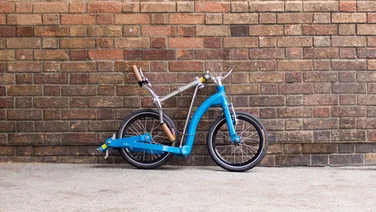To help us provide you with free impartial advice, we may earn a commission if you buy through links on our site. Learn more















- Tracking and active coaching in one product
- Three-day battery life
- A great way to learn
- Bit of extra faff at the start of each day
Skiing is an expensive business. The gear is expensive, the clothing and travel are expensive and when you get there the lift pass costs a pretty penny too.
On top of all of that, if youre just starting out, a weeks adult ski lessons will normally set you back in excess of £200. This isnt something you can skimp on, however: if you do, be prepared to spend most of your time getting closely acquainted with the piste. Face? Meet snow. Im sure youll get along just fine.
So how about a gadget that can help you improve at your own pace, without the need to book or pay for extra lessons? Thats what Carv promises.
READ NEXT: GoPro Hero 8 Black review
Carv review: What you need to know
If youre an absolute beginner youll probably still need to start with a few lessons with a proper instructor but, after that, the Carv system is designed to help you learn whenever you like.
It comes in three parts: a pressure- and motion-sensitive insole that slips into the bottom of your ski boots, a battery unit that attaches to the outside of your boots and a smartphone app that analyses your movements and feeds live coaching information into your ears as you ski. Think of it as a kind of Fitbit for alpine sports and youre half-way there.















It works astonishingly well: its no exaggeration to say you could take a handful of dry-slope lessons before you go on holiday, then switch to the Carv and learn the rest on your own terms.
And if youve heard of the Carv before, youll be pleased to learn that its been updated for this season with some new features. The third-generation hardware is smaller and neater than previous models, and it now comes with a library of instructional video content, all recorded by professional ski teachers, to help you develop your technique. The only limitation is that this clever device is for skiers only: theres no model for snowboarders, and no plans to produce one in the near future.
Carv: Price and competition
Theres no other gadget on the market that does the same job as the Carv but of course there are other ways to learn skiing. The route most people take is to have group lessons for two to three hours a day throughout the entire week of your skiing holiday. In France that would likely be with the ESF (École de Ski Francais), and can cost as much as £300 in total, depending on the resort.
Compared to that, £299 for a Carv system seems very reasonable, as youll continue to benefit from its advice and tips long after your first week of skiing.
Carv review: Set up and fitting
The Carv system comes in three sizes, so youll need to know your boot size before you buy (the sizing guide is here). Once youve picked the right model, you simply pull the liner out of each of your boots, fit the pressure-sensing Carv insole into the bottom of the shell, run the attached cable out of the top of the boot and replace the liner
If youre worried about the effect that this might have on your boot fit, fear not. The pressure sensors are less than 2mm thick, and the Kevlar-reinforced cables are flat so they dont rub or dig into your foot. I skied with the system pretty hard for a couple of days and barely noticed it was there.
Each sensor is powered by a battery unit about the size of a large DSLR battery, which clips onto your boot. In previous versions of the Carv this attached to the cuff, where it was in danger of getting a beating from chair lifts; the latest design now clips onto the strap that runs around the top of your boot, so its easier and safer to fit.















The battery packs have a capacity of 700mAh and last up to three days, assuming eight hours of skiing per day. Like all batteries, their performance drops off at extreme temperatures, but even if youre skiing in really cold conditions say -20°C you should still get a full days usage out of a charge.
The weak link, in fact, is likely to be your smartphone: at one point, after Id taken mine out a few times to check my stats, it got so cold it shut down, and I had to warm it up in a pocket to get it going again.
Once the sensor and batteries are in place, all that remains is to download the app (available on iOS now, and on Android from 20 December 2019) and register for a Carv account so you can upload your details to the cloud and pair the system with your phone.
Youll need a pair of headphones too, so you can hear the Carvs feedback and instructions while youre skiing.















Carv review: How it works
The boot sensors may not look like much, but theyre impressively high-tech. Each insole houses 48 pressure sensors spread across the whole foot from heel to toe, with nine-axis motion sensors in each of the foot arches.
These take data readings a thousand times a second, which are transmitted to your phone over Bluetooth at a rate of 25Hz, and combined with data from your phones motion sensors and GPS receiver to keep track of exactly how youre skiing, how far youve travelled and how fast.
The app can even work out which lift youre riding on, and overlay your GPS track on a resort map at the end of the day. According to the guys at Carv, total data transfer works out to around 9MB per day, so its not going to put too much of a strain on your phone battery or storage.















Carv review: On the piste
Once youve calibrated the Carvs pressure sensors by taking the weight off each foot in turn a simple process that only takes a few seconds youre free to start off with a couple of easy runs in Free Ski mode.
In this mode, the system silently monitors your skiing; then, once youre back on the lift, it gives you a Ski IQ score for the last run and offers tips on how to improve. My starting Ski IQ score was 105, which I was quite proud of but I was advised to try to keep more even pressure on each ski through the turn, and to adopt a more athletic stance.
When I tried to test the system by skiing with my legs akimbo, leaning back and putting weight on the wrong ski, the Carv correctly identified my poor form and lowered my Ski IQ to a dunce-like 79.















Each of the Carvs tips has an associated video to go with it too, with action clips from professional ski instructors showing exactly what you should be doing, so its a great way to build your technique over time that doesnt interfere with your enjoyment of the slopes.
If you want a sharper focus on developing as a skier, its well worth exploring the treasure trove of additional video content that comes with this third-generation release, which includes clips that take you through various drills and exercises.
I tried a handful of these during my time with Carv: they include pivot slips, which are designed to help your skis and knees twist independently of your hips; the exhausting thousand steps drill, in which you lift first one ski, then the other while performing turns; and outside ski, in which you turn using only the outside ski (which is more difficult than it looks).
READ NEXT:GoPro Hero 8 Black review















Probably the best way to enjoy these drills is in the live ski coaching mode, which gamifies the process. In this mode, every time Carv decides youve completed a turn correctly it will ping cheerily a pure dopamine hit of aural approval and if you string enough turns together in one session youll level up. There are 20 achievement levels in total for each of the drills, and its not easy to get to the highest levels.
My other favourite part of the Carv coaching system is the challenges. Here, youre given goals to reach the steepest edge angle, for instance, or the greatest number of completed turns in 30 seconds and the Carv will provide audio feedback during and after each challenge.
In truth, this is more fun than educational a bit like playing Guitar Hero on skis but if you can improve your highest edge angle over the course of your holiday, you know youre getting more confident. Combine this with upping your Ski IQ score and theres a great sense of achievement any fun to be had.















The system isnt just for beginners either. I have 40 years of skiing experience, but after just two days of trying out the system I found my carve turns, stance and balance had all improved noticeably. Then again, my Ski IQ score only rose to around 109: clearly, my carving technique could do with some more improvement.
The one minor caveat is some of the exercises do require you to find a relatively quiet area of the piste. You wont want to get into the middle of a series of linked turns, only to have your progress interrupted by an errant snowboarder or a train of learners in a group lesson.
Carv review: Verdict
After spending a few days using the Carv system, Im hugely impressed. No matter what level of skier you are, Im confident that a week with the system will up your game.
Perhaps whats most striking and what makes the system unique is the Carvs training and educational angle. There are plenty of systems that can report your data after youve finished your day on the slopes, but Carv goes far beyond a regular fitness tracker with tips, drills and games that can really improve your skiing.
Sure, charging and using the Carv does involve some extra faff, and theres enough faff involved in skiing as it is. But if you want to make the most of your time in the mountains, just go out and buy one. Itll add an extra dimension of enjoyment to your holiday, and youll be a better skier for it.






